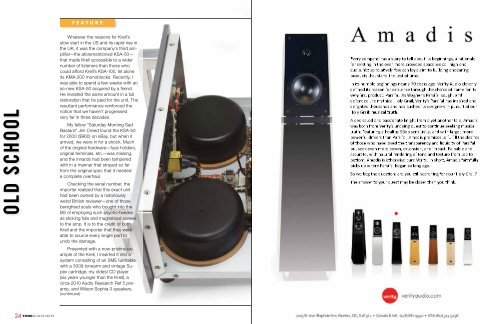Standard Resolution Version 23MB - TONEAudio MAGAZINE
Standard Resolution Version 23MB - TONEAudio MAGAZINE
Standard Resolution Version 23MB - TONEAudio MAGAZINE
Create successful ePaper yourself
Turn your PDF publications into a flip-book with our unique Google optimized e-Paper software.
OLD SCHOOL<br />
24 TONE AUDIO NO.51<br />
FEATURE<br />
Whatever the reasons for Krell’s<br />
slow start in the US and its rapid rise in<br />
the UK, it was the company’s third amplifier—the<br />
aforementioned KSA-50—<br />
that made Krell accessible to a wider<br />
number of listeners than those who<br />
could afford Krell’s KSA-100, let alone<br />
its KMA-200 monoblocks. Recently, I<br />
was able to spend a few weeks with an<br />
as-new KSA-50 acquired by a friend.<br />
He invested the same amount in a full<br />
restoration that he paid for the unit. The<br />
resultant performance reinforced the<br />
notion that we haven’t progressed<br />
very far in three decades.<br />
My fellow “Saturday Morning Sad<br />
Bastard” Jim Creed found the KSA-50<br />
for £600 ($960) on eBay, but when it<br />
arrived, we were in for a shock. Much<br />
of the original hardware—fuse holders,<br />
original terminals, etc.—was missing,<br />
and the innards had been tampered<br />
with in a manner that strayed so far<br />
from the original spec that it needed<br />
a complete overhaul.<br />
Checking the serial number, the<br />
importer realized that this exact unit<br />
had been owned by a notoriously<br />
weird British reviewer—one of those<br />
benighted souls who bought into the<br />
BS of employing such psycho-tweaks<br />
as sticking foils and magnetized screws<br />
to the amp. It is to the credit of both<br />
Krell and the importer that they were<br />
able to source every single part to<br />
undo the damage.<br />
Presented with a now-pristine example<br />
of the Krell, I inserted it into a<br />
system consisting of an SME turntable<br />
with a 3009 tonearm and vintage Supex<br />
cartridge, my oldest CD player<br />
(six years younger than the Krell), a<br />
circa-2010 Audio Research Ref 5 preamp,<br />
and Wilson Sophia 3 speakers.<br />
(continued)<br />
Every company has a story to tell about its beginnings, a raaonale<br />
for exisang in the ever-more-crowded space we call high-end<br />
audio. Yet so relaavely few can lay claim to building endearing<br />
products that stand the test of ame.<br />
In its humble beginnings nearly years ago, Verity Audio cleverly<br />
defined its reason for existence through the choice of name for its<br />
very first product: Parsifal. As Wagner’s Parsifal sought and<br />
defended the mythical Holy Grail, Verity’s Parsifal has inspired and<br />
delighted thousands and has pushed its designers in pursuit of our<br />
Holy Grail: musical truth.<br />
A dedicated and passionate knight from a yet another tale, Amadis<br />
was born from Verity’s undying quest to conanue seeking musical<br />
truth. Featuring a healthy db sensiavity, and with larger, more<br />
powerful drivers than Parsifal, Amadis promises to fulfill the desires<br />
of those who have loved the transparency and liquidity of Parsifal<br />
but seek even more power, extension, and impact. Palpable and<br />
accurate, with natural rendering of tone and texture from top to<br />
booom, Amadis is otherwise pure Verity. In short, Amadis faithfully<br />
picks up where Parsifal began so long ago.<br />
So we beg the quesaon: are you sall searching for your Holy Grail?<br />
The answer to your quest may be closer than you think.



